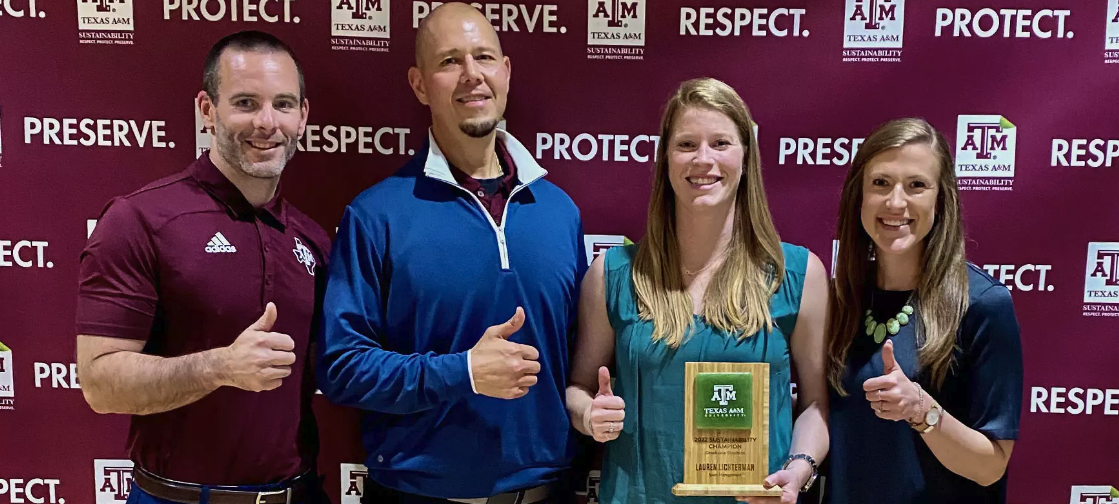Texas A&M Athletics is one of the country’s most extensive college sports programs. The Aggies have been a force in Texas and boast one of the most hallowed grounds in college football, Kyle Field in College Station. Kyle Field is one of the most sustainable stadiums in college sports.
So, it should be no surprise that Texas A&M’s athletics department is doing more. In October 2023, it unveiled a 112-page Athletics Sustainability Master Plan (ASMP) to make its college sports programs greener and carbon-neutral.
This effort is the first sustainability strategy for a college athletics program ever passed —
a strategic living document with steps toward achieving sustainable goals for the next decade. Between 2023 and 2032, short- and medium-term goals will be set each fiscal year, focusing on waste management, physical environment improvement, social sustainability, and institutional efforts. Teams will use new eco-friendly technology to meet these goals.
The document gives a timeline of sustainability at A&M, along with the importance of sustainability to fans, an assessment of the athletics department’s overall sustainability, and how to improve on already-established measures.
It also includes the 17 United Nations 2030 Sustainable Development Goals the university hopes to achieve and explains how it will hit the four focal areas and the processes involved.
“The sustainability master plan positions Texas A&M Athletics as a true off-field champion, showcasing our commitment to environmental responsibility and sustainable practices,” Kelly Wellman, Texas A&M director of the Office of Sustainability, told Texas A&M Today.

Photo Courtesy Rachel Mahan/Texas A&M Athletics
Fifty staff members formed a task force to draft this sustainability plan, which began research and development in 2021. A school-wide Sustainability Master Plan was implemented in 2018 as the university encourages its student body to live more sustainably. The 112-page document provides strategies to meet campus mobility goals, environmental action education, and further waste management goals.
The 2018 Sustainability Master Plan says that 97% of students believed sustainability was important. However, A&M wants to ensure everyone is on board, especially Aggie fans. Buy-in from the student body is crucial to reaching any of the sustainability goals outlined by the plan’s authors.
Several evergreen goals like upgrading campus public transportation, having zero landfill waste by 2050, and instituting sustainability education for athletes are in the master plan.
An exciting aspect of the report is the Zero Waste Hierarchy. It has eight levels of waste management, which ask whether materials are necessary or can be reused, recycled, or composted.
The school hopes to have a 50% reduction in greenhouse gas emissions by 2030 and achieve net-zero emissions by 2050. The ASMP includes the university’s actions and who will be key players in reducing emissions and saving energy across the sports programs.
Aggies fans, nicknamed “The 12th Man,” have promoted sustainability since 2021. The 12th Man Sustainability program was launched in June 2021 to teach environmental and social sustainability to fans and student-athletes.
Launched in 2011, the Aggie Green Fund finances several eco-friendly projects around Texas A&M. It gives grants and micro-grants to students, faculty, and staff with sustainability improvement ideas. As of 2023, the fund has awarded $2.6 million across 100 projects. In 2023, around $301,00 in major grants were given out.

Photo Courtesy Texas A&M Athletics
The athletics department has also won university awards for being one of the most sustainable organizations on campus, winning the award back-to-back years (2021 and 2022). The Sustainability Champions was given to Laura Lictherman, who co-authored the ASMP, on Earth Day 2022.
“The sustainability master plan positions Texas A&M Athletics as a true off-field champion, showcasing our commitment to environmental responsibility and sustainable practices,” Ross Bjork, former athletics director, said to Texas A&M Today. “It reflects our institution’s vision and exemplifies the bold leadership necessary to navigate the challenges of our ever-changing world. By integrating sustainable initiatives into our operations, we aim to inspire others and set an example for how athletics can contribute to a more environmentally conscious future.”





